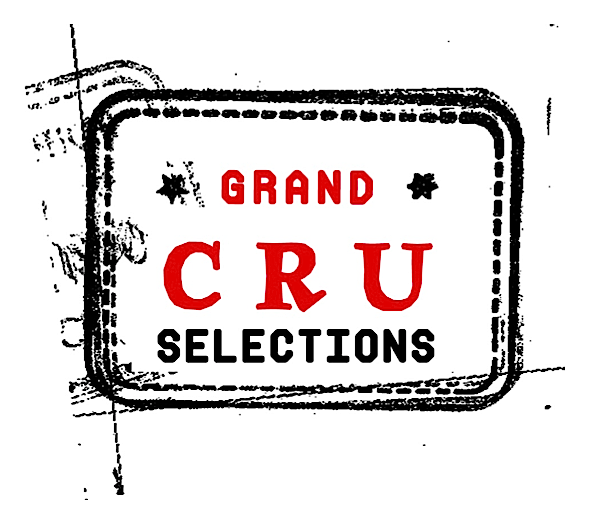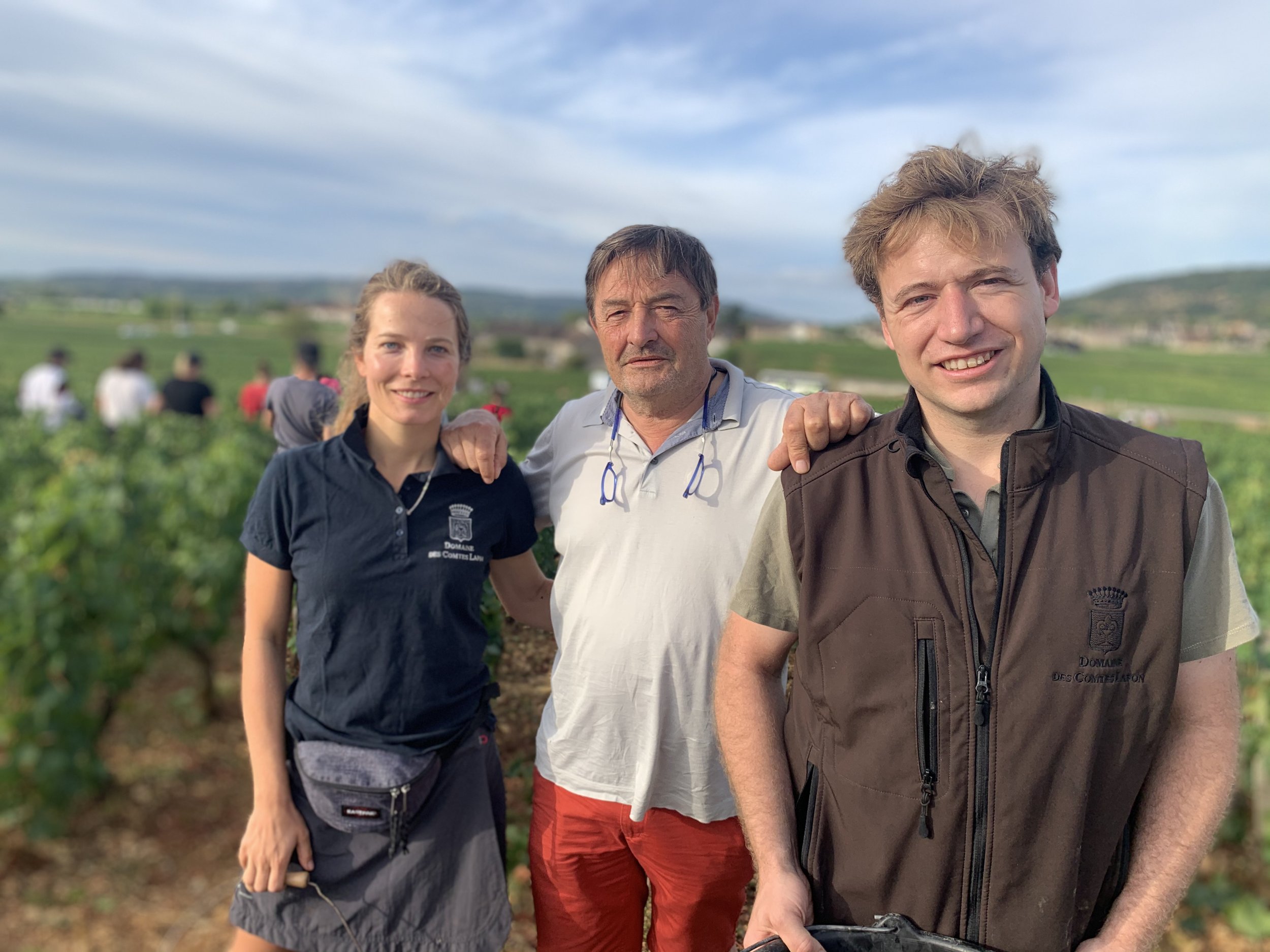domaine des Comtes Lafon
Meursault, France
Léa, Dominique & Pierre Lafon
Domaine des Comtes Lafon has been in the Lafon family since 1865. Dominique Lafon took over the domaine in 1985. It is comprised of approximately 14 hectares situated in the communes of Volnay, Monthélie, Chassagne-Montrachet, and of course, Meursault, where the domaine and its monopole vineyard Clos de la Barre are located.
“There are few growers anywhere in the world more committed to improving his vineyards with the aim of making ever better wine than Dominique Lafon. He tirelessly questions his and others’ methods, always looking to improve.” — DANIEL JOHNNES
All the vineyards are cultivated biodynamically and they proudly own every Premier Cru in Meursault. Dominique retired at the end of 2021, handing over the reigns to his daughter, Léa and nephew, Pierre, who as part of the fifth generation of winemakers in the Lafon family, will continue this domaine’s superstar reputation not only in Burgundy but throughout the world.
-
Domaine des Comtes Lafon is comprised of approximately 14 hectares situated in the communes of Volnay, Monthélie, Chassagne-Montrachet, and of course, Meursault, where the domaine and its monopole vineyard Clos de la Barre are located.
-
-
The average age of the vines is around 40 years. Yields are kept low, averaging 35hl/ha over the past decade. Dominique generally picks at full ripeness without having to worry about low acidity.
In 1992, Dominique banned all synthetic products from his vines and generalized tillage. In 1995, he started the organic conversion of the Estate. Then, having carried out trials for 3 years on several plots and observing a clear improvement in the condition of the vines, Dominique decided to adopt bio-dynamic practices for the entire domaine, not very popular in the region, except by a few other pioneers, like Anne-Claude Leflaive and Lalou Bize-Leroy. The estate became certified biodynamic in 1998.
-
Where Lafon excels is in maintaining the typicity of each of his crus. Other than the use of new oak, there is little variation in winemaking techniques. Montrachet is the only wine to be aged entirely in new oak. The premiers crus are aged in a proportion that varies from 25% to 40% and the wine stays in wood for 16 months. Lees-stirring is used sparingly – ‘usually when the fermentation is slow to finish or when the wine is reduced’, he says. Keeping the cellars cold ensures fermentations can be slow and the young wines benefit from long aging before being racked and fined.
Wines
MONTHELIE BLANC
A tiny 0.15 hectare parcel, the Monthelie Blanc was planted in 1996 just above the Monthelie-les-Duresses. Due to the severe (28%) slope, the vineyard is worked by horse and by hand. At first, the wine was only consumed at the domaine during harvest but it is now released in tiny quantities.
MEURSAULT
A blend of three parcels: En La Barre 0.61 hectares planted in 1953 and 1956 next to Clos de la Barre Produces richer wines En Luraule 0.45 hectares planted in 1975, purchased by the domaine in 1996 Located next to Goutte d'Or Produces very little wine but of extreme minerality and tension Biodynamic farming has done wonders in rehabilitating the vineyard health Les Crotots 0.17 hectares acquired in 2004, started to go into the Meursault cuvée in 2009 upon the expiration of its preexisting lease to another winemaker
MEURSAULT "CLOS DE LA BARRE"
2.12 hectares owned entirely by the domaine, encircled by a wall Shallow clay soil above hard limestone Planting dates - 1950 (0.80 ha), 1975 (0.80 ha), 1999 & 2004 (0.50 ha) The terroir produces rich, mineral wines, with pronounced citrus aromas and marked acidity.
MEURSAULT CLOS DE LA BARONNE
2012 was the first vintage that the Clos de la Baronne had been bottled as a single parcel. The bottling is sourced from the 2.7ha Clos de la Baronne, a monopole of on average 40-year-old vines.
MEURSAULT “DÉSIRÉE”
0.45 hectares in the lieu-dit of “les Petures” The name “Désirée” was used at the end of the 19th century; this precedent allows Lafon to use it, as he finds “Désirée” to be more attractive than “Petures”. The vines are planted on thin red clay that is quite suited to Pinot, so most of the lieu-dit is planted as such and is bottled as Volnay-Santenots Due to the unusual terroir for Chardonnay, this wine is always rich, somewhat exotic, and seductive in its youth.
MEURSAULT 1ER CRU GOUTTE D'OR
0.39 hectares replanted in 1991 Clay-rich soil on pebbly limestone sub-soil Vigorous terroir that must be well-managed Produces very powerful wines with ripe aromas and explosive minerality
MEURSAULT 1ER CRU CHARMES
1.71 hectares in Charmes du Dessus (the top - and best part - of the vineyard. Relatively deep clay-limestone soil, the rocks are quite crumbly, even at great depth. Produces powerful but not heavy wines
MEURSAULT 1ER CRU GENEVRIÈRES
0.55 hectares in Genevrières du Dessus (the top - and best part - of the vineyard). The parcel is located right next to Lafon's parcel of Perrières. The soil is shallow and very light, producing a wine of incredible finesse
MEURSAULT 1ER CRU PORUSOTS
The 1er Cru Porusots is an east-facing vineyard with deep clay soils. The site produces lavish, layered and deeply structured wines.
MEURSAULT 1ER CRU PERRIÈRES
0.91 hectares in 2 parcels: (1) Les Perrières Dessous - 0.77 ha towards the bottom of Perrières.Planted in 1955 (87%) and 1983 (13%) (2) Les Perrières Dessous “Perrières Ginette” - 0.14 ha towards the bottom of Perrières. Acquired in 2004. The soil is quite fine and is white from the abundance of limestone and marl on a sub-soil of flaked limestone. This is always a powerful wine, marked with Perrière's signature potent minerality
MONTRACHET GRAND CRU
0.32 hectares at the extreme southern end of the vineyard, just south of Romanée-Conti's plots 80% planted in 1953, 20% in 1972 Purchased by Comte Jules Lafon in 1918, this small piece of Montrachet is the crown jewel of the estate, producing tiny amounts of a wine of astounding richness, balance, and depth.
MONTHELIE ROUGE 1ER CRU "LES DURESSES"
1.06 hectares on the hill just behind the village 1/3 planted in 1975, 2/3 planted in 1986 and 1996 The soil is red and stony at the bottom of the hill and turns whiter at higher elevations
VOLNAY-CLOS DES CHENES
0.38 hectares planted in 1973 towards the bottom of the Clos, overlooking Caillerets. Clay-rich soil of medium depth on top of soft limestone sub-soil.
VOLNAY-CHAMPANS
0.52 hectares, 2/3 planted in 1922 (the oldest vines of the domaine, from which they often harvest cuttings) and 1/3 planted in 1989 Light soils with small stones, on crushed limestone Produces relatively dense wines that are less tannic than Santenots
VOLNAY-SANTENOTS DU MILIEU
3.78 hectares in multiple parcels purchased by Jules Lafon, Dominique's great grandfather and the founder of the domaine Plantings in 1944, 1962, 1965, 1978, 1996, and 2002 The soils are very rich in clay, yet shallow, on hard limestone bedrock. The wines are dark in color, rich, and deep, with noticeable tannins but always elegant.

